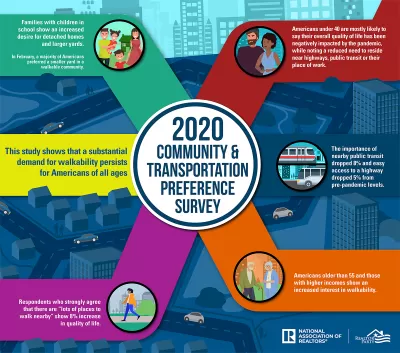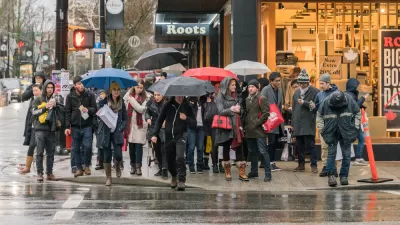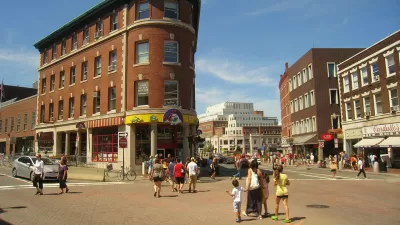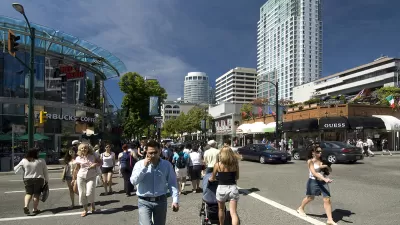The National Association of Realtors' recent Community and Transportation Preference Survey shows that many households prefer living in walkable urban neighborhoods, and those that do have a higher quality of life.

The National Association of Realtors' (NAR) 2020 Community and Transportation Preference Survey investigates how COVID has affected housing and travel preferences. It finds that many households would prefer to live in more walkable neighborhoods, and residents of such areas report a higher quality of life than those who live in less walkable areas.
NAR’s biannual Community & Transportation Preferences Surveys poll residents in America’s 50 largest metropolitan areas. The first 2020 survey was conducted in February, immediately before the impacts of COVID-19 began to be felt, and again at the end of July.
The survey found that Americans under 40 (millennials and Generation Y) are most likely to say their overall quality of life has been negatively impacted by the pandemic, while they also note a reduced need to reside near highways, public transit or their place of work. Although COVID has dramatically changed people’s lives, this study shows that a substantial demand for walkability persists for Americans of all ages,” Malta added.
Among other noteworthy findings of the July survey:
- Respondents who strongly agree that there are “lots of places to walk nearby” show an 8% increase in quality of life.
- Americans older than 55 and those with higher incomes show an increased interest in walkability.
- Families with children in school show an increased desire for detached homes and larger yards.
- The importance of easy access to public transit and highways dropped 8% and 5%, respectively, from pre-pandemic levels.
FULL STORY: Community and Transportation Preference Surveys

Study: Maui’s Plan to Convert Vacation Rentals to Long-Term Housing Could Cause Nearly $1 Billion Economic Loss
The plan would reduce visitor accommodation by 25,% resulting in 1,900 jobs lost.

North Texas Transit Leaders Tout Benefits of TOD for Growing Region
At a summit focused on transit-oriented development, policymakers discussed how North Texas’ expanded light rail system can serve as a tool for economic growth.

Why Should We Subsidize Public Transportation?
Many public transit agencies face financial stress due to rising costs, declining fare revenue, and declining subsidies. Transit advocates must provide a strong business case for increasing public transit funding.

How to Make US Trains Faster
Changes to boarding platforms and a switch to electric trains could improve U.S. passenger rail service without the added cost of high-speed rail.

Columbia’s Revitalized ‘Loop’ Is a Hub for Local Entrepreneurs
A focus on small businesses is helping a commercial corridor in Columbia, Missouri thrive.

Invasive Insect Threatens Minnesota’s Ash Forests
The Emerald Ash Borer is a rapidly spreading invasive pest threatening Minnesota’s ash trees, and homeowners are encouraged to plant diverse replacement species, avoid moving ash firewood, and monitor for signs of infestation.
Urban Design for Planners 1: Software Tools
This six-course series explores essential urban design concepts using open source software and equips planners with the tools they need to participate fully in the urban design process.
Planning for Universal Design
Learn the tools for implementing Universal Design in planning regulations.
Ascent Environmental
Borough of Carlisle
Institute for Housing and Urban Development Studies (IHS)
City of Grandview
Harvard GSD Executive Education
Toledo-Lucas County Plan Commissions
Salt Lake City
NYU Wagner Graduate School of Public Service





























